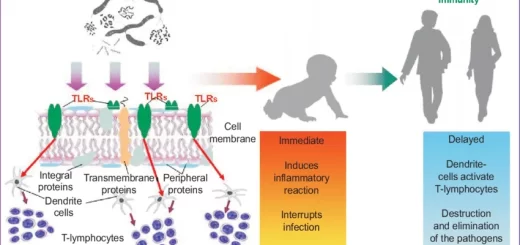Types of protein synthesis inhibitors antibiotics and Uses of individual aminoglycosides
The protein synthesis inhibitor can stop or slow the growth or proliferation of cells by disrupting the processes that lead directly to the generation of new proteins, The ribosome is a biological machine that utilizes protein dynamics on nanoscales to translate RNA into proteins.
Protein synthesis inhibitors
Protein synthesis inhibitors act at the ribosome level, taking advantage of the major differences between prokaryotic and eukaryotic ribosome structures, they work at different stages of prokaryotic mRNA translation into proteins like initiation, elongation, and termination, By targeting different stages of the mRNA translation, antimicrobial drugs can be changed if resistance develops.
This antibacterial group includes:
- Aminoglycosides.
- Macrolides.
- Tetracyclines.
- Lincosamides.
- Chloramphenicol.
- Linezolid.
Aminoglycosides
They include Streptomycin, Gentamicin, Neomycin, Tobramycin, Amikacin, and structurally related; spectinomycin.
Spectrum: Aminoglycosides have concentration-dependent killing and a post-antibiotic effect, They have a narrow antibacterial spectrum that includes:
- They are active against aerobic Gram-negative bacilli including Pseudomonas, particularly the more resistant bacteria associated with hospital-acquired infections.
- They show synergism with beta-lactams; they promote their uptake.
- They are effective against Gram-positive enterococci when combined with beta-lactams.
- They are ineffective against anaerobes due to a lack of oxygen-dependent active transport and against atypical bacteria.
Aminoglycosides toxicities availability of other less toxic antimicrobials would not make the drugs of choice for many infections.
Pharmacokinetics
Absorption: Aminoglycosides highly polar structure prevents adequate absorption after oral administration, Therefore, all aminoglycosides must be given parenterally to achieve adequate serum levels, Some aminoglycosides (e.g., neomycin) are given orally to act on intestinal bacteria.
Distribution
Due to their hydrophilicity, tissue concentrations are low. Concentrations in CSF are inadequate, even in the presence of inflamed meninges, Aminoglycosides levels in pulmonary secretion are 10 to 45% of simultaneously measured plasma concentration, Since the toxic effect limit the dosing capability of aminoglycosides, the level achievable in respiratory tissue may be inadequate to eradicate Enterobacteriaceae, Moreover, aminoglycosides perform poorly in an acidic environment associated with pneumonia, particularly in areas of the abscess.
Elimination
More than 90% of the parenteral aminoglycosides are excreted unchanged in the urine by glomerular filtration. Accumulation occurs in patients with renal dysfunction and dose adjustments are required depending on creatinine clearance.
Therapeutic uses of individual aminoglycosides
- Gentamicin, amikacin, and tobramycin are used in serious infections with aerobic, and Gram-negative bacteria.
- Gentamicin combined with ampicillin is used in Enterococcal endocarditis.
- Streptomycin is used in Tuberculosis.
- Neomycin and Kanamycin (Never parenteral because they are highly toxic) are used in ( Topical: skin infections, Oral: Bowel sterilization).
- Spectinomycin is used in a single intramuscular dose for Gonorrhea.
Adverse Reactions
1. Ototoxicity
- It is irreversible and in the form of auditory damage (ie. hearing deficit) or vestibular damage (balance disturbance)
- It is more common with renal impairment (if the dose in not adjusted) and in the presence of other ototoxic drugs, e.g.. loop diuretics
- Ototoxicity may follow fetal exposure: Aminoglycosides are contraindicated in pregnancy.
2. Nephrotoxicity: It is reversible and more common in elderly patients and in the presence of other nephrotoxic drugs, e g., cephalosporins, and vancomycin.
Macrolides
They include erythromycin, clarithromycin, and azithromycin.
- Gram-positive cocci, e.g.. Streptococci and Gram-positive bacilli, e.g., Corynebacterium diphtheriae.
- Few Gram-negative bacilli, e.g. H. influenzae, H. pylori.
- Most useful against atypical organisms, e.g. Mycoplasma and Chlamydia species.
- No anaerobic coverage.
Therapeutic uses
- Streptococcal throat infection in penicillin-allergic patients.
- Community-acquired pneumonia (CAP): Due to increasing evidence of macrolide-resistant Streptococcus pneumoniae (the most common organism of CAP), it is recommended that macrolides are combined with beta-lactams (amoxicillin/clavulanic or cefuroxime), Beta lactams will cover macrolide-resistant Streptococcus pneumoniae and H. influenzae, while macrolide will cover the atypical bacteria like Chlamydia.
- Clarithromycin is a component of H. pylori eradication drug regimens for peptic ulcer disease.
- Treatment of gonorrhea: Azithromycin is combined with ceftriaxone to increase its efficacy and eradicate chlamydial coinfection.
- Azithromycin is used for the treatment of nonspecific urethritis and typhoid fever.
Adverse Reactions
- Gastrointestinal upsets that are less with azithromycin and clarithromycin.
- Cholestatic hepatitis occurs with erythromycin.
- QT interval prolongation: combination with other drugs that prolong QT intervals may lead to Torsade de pointes’.
Tetracyclines
They include minocycline, doxycycline, tetracycline, and tigecycline.
Spectrum:
They are broad-spectrum bacteriostatic antibiotics. They are effective against:
- Gram-positive and Gram-negative bacteria; however, many species are resistant now.
- Atypical bacteria: Chlamydia and Mycoplasma.
- Some protozoa Amoeba and Malaria parasites.
- Rickettsia, which is a diverse collection of obligatory intracellular Gram-negative bacteria.
- They are not effective against Pseudomonas.
Pharmacokinetics
Absorption:
- Tetracyclines have variable absorption with oral administration, In the exception of doxycycline and minocycline which have almost complete absorption after oral administration, Tigecycline has limited absorption after oral administration, thus, it is given mainly parenterally.
- Food may reduce the absorption of tetracycline by 50 %, so it is better to be taken it one hour before or two hours after meals.
- All tetracyclines are affected by food or drugs containing calcium, iron, magnesium, zinc, and aluminum, therefore, they should not be administered concurrently with them.
Distribution:
- They distribute rapidly and extensively in the body and high concentrations are present in the kidney, liver, lungs, and bone.
- The more lipid-soluble tetracyclines (doxycycline and minocycline) readily penetrate the blood-brain barrier.
- They cross the placental barrier and may be teratogenic to the fetus as they can be deposited in the developing bones.
Excretion: Doxycycline and tigecycline are eliminated primarily by non-renal mechanisms, they do not require dose reduction in renal impairment.
Therapeutic uses
- Community-acquired Pneumonia: Doxycycline combined with beta-lactams can substitute azithromycin for the treatment of CAP.
- Chlamydial urethritis: A 7-day course of doxycycline is recommended. Moreover, it is combined with ceftriaxone for the treatment of gonorrhea to treat chlamydial co-infection.
- Syphilis: doxycycline or tetracycline are alternatives to a single injection of benzathine penicillin in penicillin-allergic patients, and the duration of therapy is 14 days.
- Brucellosis: Combination therapy of oral doxycycline plus streptomycin, gentamicin or rifampin is recommended.
- H. pylori eradication drug regimens for peptic ulcer disease: in which doxycycline or tetracycline is included.
- Malaria prophylaxis and treatment of amebiasis, as well as cholera and rickettsia infection: doxycycline is used.
Adverse Reactions
1. It could be deposited in growing bone and during calcification of the teeth, therefore, it is contraindicated in pregnancy. It could lead to permanent yellowish discoloration and hypoplasia of the teeth and transient inhibition of bone growth of the offspring. It is contraindicated in children under the age of 8 years.
2. Gastrointestinal upsets:
- Heartburn, nausea, and vomiting. The patient should be advised not to drink milk or take antacids to relieve this heartburn.
- Superinfection: Pseudomembranous colitis due to infection by Clostridium difficile or oral candidiasis.
3. Hepatotoxicity: It is more likely to occur with pre-existing hepatic disease and pregnant patients. It may progress to hepatic necrosis.
4. Photosensitivity to sunlight or ultraviolet rays: Photosensitivity reactions ranged from itching and burning sensation to mild erythema of sun-exposed face and extremities. It is rare with no permanent sequels. It is advisable to instruct the patient to avoid direct sunlight exposure.
5. Vestibular reaction: dizziness, vertigo, nausea, and vomiting are reported with minocycline and doxycycline.
Drug interactions
- Concomitant use of tetracyclines with antacids, dairy products, and iron should be avoided.
- Since bacteriostatic drugs may interfere with the bactericidal action of penicillin, it is advisable to avoid giving tetracyclines in conjunction with penicillin.
Tigecycline
Spectrum: Tigecycline has an expanded spectrum of activity and decreased susceptibility to the development of resistance compared to other tetracyclines. It has activity against many resistant Gram-negative (but not Pseudomonas and Gram-positive (including MRSA) bacteria and anaerobes.
Therapeutic Uses: Tigecycline is approved for the treatment of complicated skin and skin structure infections and complicated intra-abdominal infections caused by susceptible organisms.
Lincosamides
They include clindamycin.
Spectrum: It has narrow spectrum antimicrobial activity involving:
- Gram-positive cocci (MSSA, community-acquired MRSA, Streptococci).
- Anaerobes (Classically for oral anaerobes and some gastrointestinal tract anaerobes but not Clostridium difficile).
Pharmacokinetics
Clindamycin is widely distributed in body fluids and tissues with excellent bone and soft tissue penetration, but it does not reach CSF in significant concentrations. It penetrates well into abscesses and is actively taken by phagocytic cells, Only 10% is excreted in urine within 24 hours, thus it does not require dose reduction in renal impairment.
Therapeutic uses
- Osteomyelitis: As an alternative antibiotic for skin infection case of severe penicillin allergy.
- Topical clindamycin is used for acne.
Adverse Reactions
Hypersensitivity reactions.
Pseudomembranous colitis: This condition may occur due to the overgrowth of Clostridium difficile, which can be treated by metronidazole or vancomycin.
Chloramphenicol
Spectrum: Despite its wide range of antimicrobial activity, it has limited use because of its serious adverse reactions and the increased incidence of bacterial resistance, It covers:
- Gram-positive bacteria, except Enterococcus.
- Gram-negative bacteria, except Enterobacter, Pseudomonas, and Proteus.
- Anaerobes.
Pharmacokinetics
Chloramphenicol is rapidly and completely absorbed from the gastrointestinal tract and is not affected by food ingestion or metal ions. Parenteral administration is generally reserved for situations, in which oral therapy is contraindicated as in the treatment of meningitis septicemia.
It penetrates the brain and crosses the placental barrier, Chloramphenicol is inactivated in the liver by glucuronosyltransferase and is rapidly excreted (80-90% of dose) in the urine.
Therapeutic uses
- Meningitis: it is not used empirically. It is used as a specific antibiotic treatment after the identification of causative microorganisms through culture and antibiotic susceptibility testing. It is an alternative drug for the treatment of Streptococcus pneumonia, N. meningitidis, and H. influenzae.
- Typhoid fever and paratyphoid fever: The recent improvement in susceptibility of Salmonella typhi to chloramphenicol (despite its lower performance compared to ceftriaxone), resulted in its re-consideration again as one of the drugs of choice for the treatment of typhoid fever in Egypt.
- It is used topically in the treatment of eye infections as ophthalmic drops and ointments.
Adverse Reactions
- Gastrointestinal upsets: It is either due to direct irritation or superinfection.
- Bone marrow suppression: Anemia is dose-dependent and reversible.
- Aplastic anemia is a rare and idiosyncratic reaction that is irreversible and fatal.
- Gray Baby syndrome is manifested by cyanosis and circulatory failure. It is more likely to occur in premature neonates due to less glucuronyl transferase activity.
Linezolid
Spectrum: It has activity against all Gram-positive cocci including MRSA, Vancomycin Resistant Staph aureus (VRSA) and Vancomycin-Resistant Enterococci (VRE).
Pharmacokinetics
It has excellent oral bioavailability and when given orally, it achieves plasma concentrations comparable to the intravenous route. It does not need dose adjustment for renal failure.
Therapeutic Uses: MRSA infections.
Adverse Reactions
- Thrombocytopenia.
- Serotonin syndrome occurs if given with other drugs increasing serotonin. This is due to its ability to inhibit the MAO enzyme responsible for the metabolism of serotonin.
You can follow science online on Youtube from this link: Science online
You can download Science Online application on Google Play from this link: Science online Apps on Google Play
Cephalosporins antibiotics types, examples, Carbapenems, Monobactams & Glycopeptides
Antibacterial drugs definition, use & types, Penicillin classification and importance
Antimicrobial drugs types, use, side effects, resistance & Empiric antimicrobial therapy
Vaccines types, Live vaccines, Inactivated vaccines, Subunit vaccines, Naked DNA & mRNA vaccines




